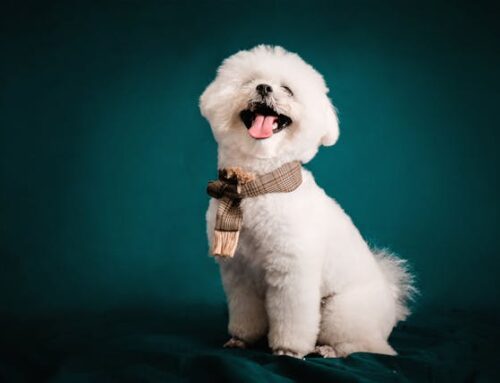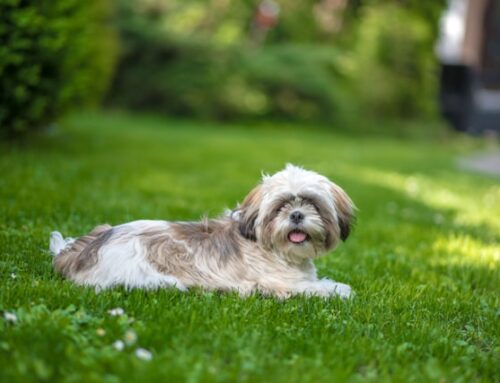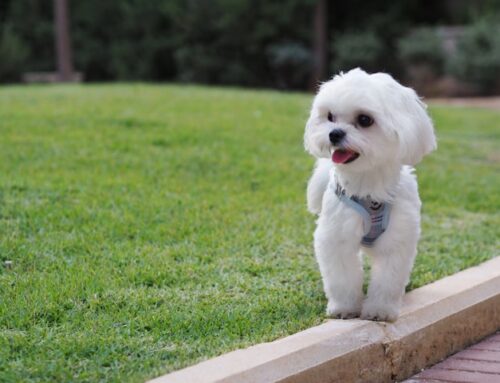Overview
Introduction to Crate Training A Puppy

In 2024, crate training a puppy has become a cornerstone for many new pet parents, offering a safe and effective method for teaching pups valuable skills.
Whether you’re introducing your furry friend to their crate door for the first time or looking to enhance their existing crate training, mastering this technique can make a world of difference.
Dogs, known as den animals, naturally seek out small, cozy spaces to rest, making a crate a comforting choice for many pets. From selecting the perfect crate mat to ensuring your pup feels comfortable and secure, this guide will provide you with top tips to crate train your puppy like a pro. Let’s dive in!
What is Crate Training?
Crate training a puppy involves teaching a young dog to accept and even enjoy spending time in a crate. It provides a safe and secure space for the puppy when unsupervised, helping with housebreaking and preventing destructive behavior.
When done correctly, crate training can become a positive experience for both the puppy and the owner.
Benefits of Crate Training
Crate training offers numerous benefits for puppies and their owners. A dog crate provides a safe and secure environment for a puppy, mimicking the den-like spaces preferred by dogs in the wild. It can help reduce anxiety and stress, especially when left alone, by providing a familiar and comforting space.
Properly crate trained puppies are also less likely to develop destructive behaviors when unsupervised. Additionally, crate training can aid in house training and teach puppies to control their bladder and bowels.
Using positive reinforcement techniques, such as treats and praise, can make crate training a positive experience for puppies of any age.
Misconceptions about Puppy Crate Training
There are several misconceptions about puppy crate training, one being that a wire crate is the only suitable option. While wire crates are popular, some dogs may prefer other types, such as plastic or fabric crates. Another misconception is that most dogs can tolerate being in their crate overnight without issue.
However, some dogs may experience separation anxiety or discomfort, requiring a gradual acclimation process to the crate. It’s important to create a positive association with the crate and address any whining or anxiety the dog may exhibit.
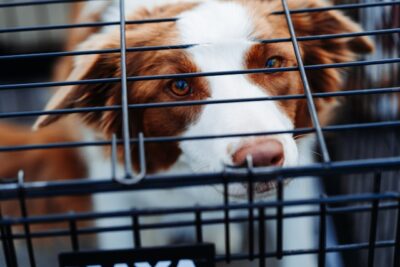
Preparing for Puppy Crate Training
Choosing the Right Crate
Preparing for puppy crate training involves careful crate selection, considering the adult size of your furry friend. Choosing the right crate ensures comfort and safety, providing a cozy den-like space for your puppy to relax and sleep in.
Selecting a crate that accommodates your puppy’s future adult size helps with training consistency and avoids the need for frequent crate upgrades.
Setting Up the Crate
Preparing for puppy crate training involves setting up the crate with a comfortable bedding, a few toys, and a food dish to make it inviting.
Place the crate in a quiet, but not isolated, area where your puppy can still feel part of the family. Covering the crate with a blanket can create a den-like environment, which many dogs find comforting.
Introducing Your Puppy to the Crate
Preparing for puppy crate training involves introducing your new puppy to the crate gradually. Start by placing a few treats or their meals in the crate to make it a positive experience.
Encourage your puppy to explore the crate on their own, and when they enter voluntarily, praise them and let them stay inside for short periods. This helps the crate feel like their safe haven and own space, where the family spends time together, even if the dog whines initially.
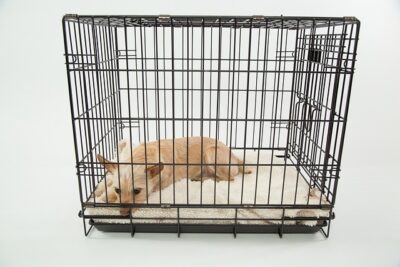
Getting Started with Puppy Crate Training
Day One: Introduction to the Crate
Getting started with puppy crate training begins with introducing your dog to the crate on day one. Place your dog’s crate in a family room and leave the door open. Encourage your dog to sit quietly inside the crate by tossing treats inside.
Continue tossing treats for a few minutes while your dog is inside the crate. Gradually increase the time your dog spends inside the crate, starting with short periods of time with the door open.
Eventually, you can close the door while your dog eats meals inside the crate. Make the crate a comfortable and inviting space by placing it in a small, cozy area away from direct sunlight to avoid creating negative associations.
Day Two: Positive Association with the Crate
Getting started with puppy crate training on day two involves creating a positive association with the crate. Encourage your puppy to enter the crate by using treats or toys, and praise excited behavior around the crate.
Allow your dog to enter the crate voluntarily and gradually extend the periods of time your puppy spends inside. Start closing the door for short periods while your puppy is in the crate, ensuring they are comfortable with the small space. Begin leaving your puppy in the crate for short periods, even with the door closed, to help them associate the crate with quiet time.
Avoid creating a negative association by never forcing your puppy into the crate or leaving them inside for extended periods, especially during the initial stages of training or for overnight stays.
Day Three: Feeding and Watering in the Crate
On day three of puppy crate training, focus on feeding and watering your puppy in the crate. Start by placing your puppy’s regular meals inside the crate and leave quietly while they eat. Encourage your puppy to enter the crate willingly by using treats or a stuffed Kong.
Close the door for short periods while your puppy is eating to help them get used to spending time in the crate with the door closed. Gradually increase the time spent in the crate after meals to help your puppy associate the crate with positive experiences.
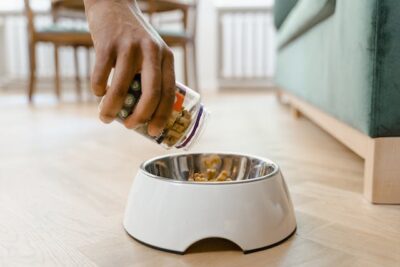
Establishing a Routine
Creating a Schedule for Crate Use
Establishing a routine for puppy crate use involves creating a schedule that includes times when your dog will be in the crate. Encourage your dog to enter the crate voluntarily by using treats or toys.
Ensure the crate is large enough for your dog to be comfortable, especially if you have a new dog. Use the crate as a safe place where your dog can relax and keep them in the crate for longer periods when you’re away from the house.
Using the Crate for Naps and Bedtime
Establishing a routine that includes using the crate for naps and bedtime can help your puppy develop good sleeping habits.
Ensure the crate is comfortable and inviting, with soft bedding and familiar toys. Encourage your puppy to enter the crate voluntarily, and gradually increase the time they spend in it to help them adjust.
Incorporating Crate Time into Daily Activities
Incorporating crate time into your puppy’s daily routine can help establish good habits and provide a sense of security. Gradually increase crate time during quiet periods, such as after playtime or meals, to help your puppy adjust comfortably.
Ensure the crate is a positive space by placing familiar bedding and toys inside when your puppy is in the crate.

Using the Crate for Housebreaking
Utilizing the Crate for Potty Training
Using the crate for housebreaking can be an effective tool in potty training your pup. Ensure the crate is appropriately sized, allowing enough room for the pup to stand, turn around, and lie down comfortably.
When your dog enters the house after being outside, immediately use the crate for short periods to prevent accidents and encourage bathroom breaks outside.
Consistency is key; take your pup outside frequently, especially after meals and naps, and praise them for going potty in the right spot.
Establishing a Potty Schedule
Establishing a potty schedule when using the crate for housebreaking is crucial for your dog’s success. Keep your dog in the crate when you’re unable to supervise them closely, and take them outside immediately after they come out of the crate to a designated potty area.
Consistency is key; establish regular times for bathroom breaks, such as after meals and naps, and reward your dog for successful trips outside. With patience and a consistent routine, your pup will learn to associate the crate with good behavior and develop healthy potty habits.
Dealing with Accidents in the Crate
Dealing with accidents in the crate while housebreaking can be frustrating but is a normal part of the process. Ensure the crate is the right size for your dog, not too big to encourage pottying in one corner. Clean accidents thoroughly to remove odors that might attract your dog to repeat the behavior.
Stay patient and consistent with the potty training routine, and accidents in the crate should decrease as your dog learns.
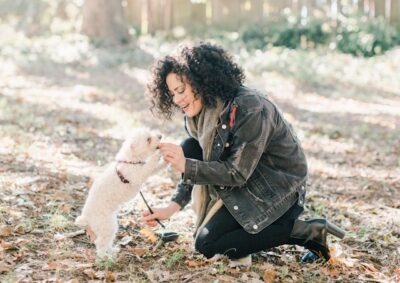
Crate Training A Puppy Tips and Techniques
Using Positive Reinforcement
When crate training a puppy, using positive reinforcement can be highly effective. Reward your dog with treats and praise when they enter the crate willingly, and gradually increase the amount of time they spend inside.
Use a command like “go to your crate” to associate the crate with a positive action. With patience and consistency, your dog will become crate trained and eventually fully crate trained, viewing the crate as a safe and comfortable space.
Avoiding Negative Associations
To avoid negative associations with crate training a puppy, ensure it’s a positive and comfortable environment for your dog. Never use the crate as a form of punishment. Instead, make it inviting with soft bedding and toys, and gradually increase crate time while rewarding calm behavior.
With patience and positive reinforcement, your dog will become crate trained and eventually fully crate trained, associating the crate with safety and relaxation.
Gradual Increase in Crate Time
Gradually increasing crate time is key to successful crate training a puppy. Start with short periods and gradually lengthen them as your dog becomes more comfortable.
Use treats and positive reinforcement to create a positive association with the crate. With patience and consistency, your dog will learn to see the crate as a safe and comfortable space.

Common Crate Training Issues
Whining and Barking in the Crate
Whining and barking in the crate are common issues during crate training. To address this behavior, ensure the crate is comfortable and associated with positive experiences.
Ignore the whining if you’re confident your puppy doesn’t need to use the bathroom, and only let them out when they’re quiet to avoid reinforcing the behavior.
Crate Anxiety and How to Manage It
Crate anxiety, often seen as whining, barking, or attempting to escape the crate, can occur during crate training. To manage it, gradually accustom your dog to the crate by associating it with positive experiences and leaving the crate door open initially.
Use treats and praise to create a positive association, and gradually increase crate time while your dog is comfortable and calm inside.
Escaping or Destructive Behavior in the Crate
Escaping or destructive behavior in the crate can be common during crate training. To address this, ensure the crate is secure and the right size for your dog.
Gradually crate train your dog, starting with short periods and gradually increasing time spent in the crate. Provide engaging toys and treats to keep your dog occupied and create a positive association with the crate.

Graduating from Crate Training
Knowing When Your Puppy is Ready
Graduating from crate training depends on your puppy’s behavior and maturity. Signs that your puppy is ready to spend more time out of the crate include being consistently well-behaved and not having accidents in the house.
Start by leaving your dog in the crate for short periods while you’re home, gradually increasing the time as they become more comfortable being outside the crate.
Transitioning to Alone Time Without the Crate
Transitioning from crate training to alone time without the crate involves gradually increasing your dog’s freedom while monitoring their behavior.
Start by leaving them alone in a puppy-proofed room for short periods, gradually extending the time as they become more comfortable. Provide plenty of toys and distractions to keep them occupied during this transition period.
Maintaining Crate Use for Travel or Safety
Even after your dog has graduated from full-time crate use, you can still maintain crate use for travel or safety. Use the crate during car rides to keep your dog safe and secure.
Additionally, the crate can be a safe haven for your dog when they need some alone time or during stressful situations.
Conclusion: Crate Training A Puppy
Recap of Benefits of Crate Training a Puppy
Crate training a puppy offers numerous benefits for puppies and their owners. A dog crate provides a safe and secure environment for a puppy, mimicking the den-like spaces preferred by dogs in the wild. It can help reduce anxiety and stress, especially when left alone, by providing a familiar and comforting space.
Properly crate trained puppies are also less likely to develop destructive behaviors when unsupervised. Additionally, crate training can aid in house training and teach puppies to control their bladder and bowels.
Final Thoughts on Crate Training Success
Crate training a puppy is a valuable tool for pet parents, offering a safe and effective way to teach puppies valuable skills. Whether you’re introducing your furry friend to their crate door for the first time or enhancing their existing crate training, mastering this technique can make a world of difference.
By using positive reinforcement techniques and gradually increasing crate time, you can help your puppy view the crate as a safe and comfortable space. With patience and consistency, your puppy will become crate trained and develop healthy habits that last a lifetime.
Continued Use of the Crate for a Happy, Well-Adjusted Puppy
Even after your puppy has graduated from full-time crate use, the crate can continue to be a valuable tool for crate training a puppy. Use the crate for travel or as a safe space for your puppy to relax and unwind.
By maintaining crate use for short periods, you can help your puppy feel comfortable and secure in new environments. The crate can also be a useful tool for managing behavior and providing structure in your puppy’s daily routine.
At Georgia Puppies Online, we understand the importance of proper crate training for your puppy’s well-being. That’s why we offer puppies for sale in Georgia and surrounding areas that are thoughtfully bred and raised by reputable breeders. From day one, we value and adore each and every charming canine in our care.
Our puppies receive regular health checks, socialization, and affectionate interaction to ensure they meet your expectations. Explore our delightful selection of puppies for sale in Georgia, where each furry friend is raised with love and care to become a cherished addition to your family. Adopt your new companion today.
Frequently Asked Questions (FAQs): Crate Training A Puppy
- Q: Can I crate train adult dogs, or is it only for puppies?
- A: Crate training can be beneficial for dogs of all ages, including adult dogs. It can help with housebreaking, providing a safe space, and preventing destructive behavior.
- Q: Do I need to crate large or older dogs?
- A: Crate training can be effective for large and older dogs, especially if they need help with housebreaking or if they have anxiety issues. However, it’s important to ensure the crate is large enough for them to stand, turn around, and lie down comfortably.
- Q: How can I make the crate a comfortable space for my dog?
- A: To make the crate inviting, add soft bedding, toys, and treats. Make sure the crate is in a quiet, comfortable location in your home.
- How long should I leave my puppy in the crate?
- A: The amount of time you leave your puppy in the crate will depend on their age and bladder control. As a general guideline, puppies can typically hold their bladder for one hour for every month of age, up to a maximum of about 8 hours.

